Create, modify, or delete a view
You can use views to see the items in a list or library that are most important to you or that best fit a particular purpose. For example, you can create views of the files in a library that apply to a specific department or the items in a list that were created by a specific person. Views are available for the list or library you create them in.
Each list or library has at least one view, based on the type of list or library and how it was configured. In the browser, you can modify these views and create new views. For example, a task list includes several views, such as Due Today and All Tasks. You can modify these views, for example, by changing how the items in a list are sorted. You can also create new views that show only incomplete tasks.
In addition to using the browser, you can use Microsoft SharePoint Designer 2010 to create highly customized views, and Microsoft Access to create forms and reports that are based on the list.
In this article
Planning your view
Before you begin
Before creating a view, you may want to add columns to the list or library to enable more flexibility for sorting, grouping, and filtering the items in the list or library. For example, people may want to see only the documents in a library that apply to their department or the items in a list sorted by the project number.
If you are creating views that will be accessed by phones and other mobile devices, you need to consider the capabilities of the mobile devices.
Types of views
When you create a view, you must first choose whether you want to base the view on:
-
A predefined format, such as calendar
-
An existing view
-
A custom view created by using SharePoint Designer 2010
-
Forms and reports created by using Microsoft Access
The option that you choose determines the requirements for the data in the list or library and how the information will be displayed. For example, to create a Calendar view, the list or library must contain columns that can be used for the start dates and the end dates of the calendar items.
Note: Once created, you cannot change the format of a view, such as from a calendar to a Gantt view.
All formats are not available for all types of lists and libraries. For example, there are view formats that are available only for discussion boards. The following are the formats available. Custom formats may also be available on a site.
-
Standard This view displays your list and library items one row following another. Standard view is the default for most types of lists and libraries. You can customize the view in many different ways, such as by adding or removing columns from the view.
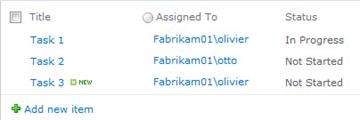
-
Standard View, with Expanded Recurring Events This view displays your list and library items one row after another. Use this view if you want to see each instance of a recurring event.
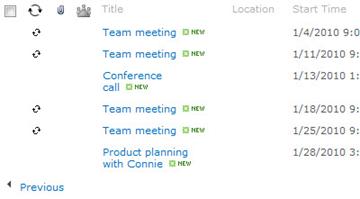
-
Calendar This view displays your list and library in a format similar to a wall calendar. You can apply daily, weekly, or monthly views in this format. This view can be helpful if you want to see the items in the list or library chronologically.
Calendar views have requirements that differ from the other formats.
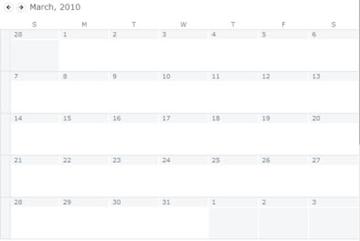
-
Datasheet This view displays list and library items in a grid, similar to a spreadsheet. This view can be helpful if you have to edit many items in a list or library at the same time. This view is also helpful if you want to export your data to a spreadsheet or database program. Datasheet view requires a control or program that is compatible with SharePoint, such as Microsoft Office 2010, and ActiveX control support.

-
Gantt This view displays list and library items in bars that track progress. A Gantt view can help you manage projects. You can use this view, for example, to see which tasks overlap each other and to visualize overall progress.

The following are the other options that you can base your view on:
-
Existing view If an existing view is almost the view that you want, you can save time by using an existing view as the starting point for creating your new view.
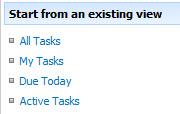
-
Access View Use Microsoft Access to create forms and reports that are based on the list or library.
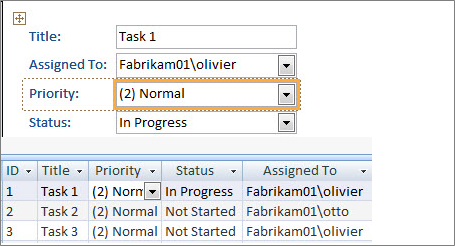
-
Custom View in Designer Use the features of Microsoft SharePoint Designer 2010, such as changing the width of columns, to create custom views for your list or library.
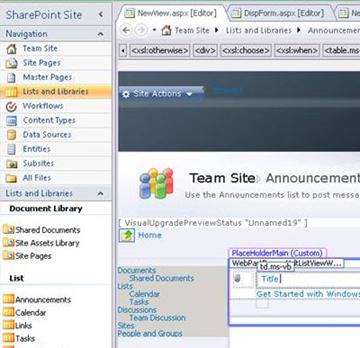
Settings for views
Views have many settings to help make it easier for you to quickly find the information that you need in a list or library. The following are the settings for SharePoint views. All settings are not available for all types of views. The settings for calendar views differ from other types of views.
Important: The maximum number of items in a view is 5000. You can manage the number of items in a view by using the filter and item limit settings.
-
Default view A default view is provided for all lists and libraries. You can change the default view to any public view for the list or library; you cannot use a personal view. To delete a view that is the default view, you must first make another public view the default.
Note: If Make this the default view is not displayed on the create or edit view pages, you do not have the necessary permissions to create a public view or the view is a personal view. To create a public view you must have at least the wspermissions obtained by being added to the default Designer group for the site.
-
Personal and public views When you create a view, you can configure the audience for the view to be personal or public. A personal view is available only to you when you look at the list or library. A public view is available when anyone looks at the list or library.
You cannot change a personal view to a public view or a public view to a personal view. You can use a public view as the starting point for personal or public views. You can use a personal view as the starting point only for personal views.
When you create a view, if Create View is disabled you do not have the necessary permissions to create a personal or public view. If the Create a Public View option is disabled you do not have the necessary permissions to create a public view. To create a personal view, you must have the contribute permission level for the list or library, such as by being member of the default site name Member group. To create a public view, you must have the design permission level for the list or library, such as by being member of the default Designer SharePoint group for the site.
-
Columns The columns in a view can provide, at a glance, the information that you need for list or library items. This can eliminate the need to open each item to see the item details. Columns, in combination with other features of views, such as filters, can help you see only the information that is most important to your work. This is especially helpful if the list or library contains lots of items.
-
Gantt Columns Select the columns that will be in the Gantt view. Title is a required text field. Start Date, and Due Date are required date fields. When you select a column, such as Title, if no option displays in the drop-down list, you must create the column to support this view.
-
Sort Set the order items are displayed in the view. You can have up to two criteria. For example, show the items in a task list sorted by priority and then by due date.
-
Filter Configure a view to display a subset of the items in a list or library by filtering them with information in columns of the list or library. For example, a view can show the documents in a library that are for a specific project.
-
Inline Editing Enable editing of list and library items in the view, without having to open each item to edit it. This can save lots of time if many items in a list or library must be changed. This does not apply to the files in a library. They must be edited in the applicable program, such as Microsoft Word.
-
Tabular View Provides check-boxes for each item so that users can select multiple list or library items to perform bulk operations. This can save lots of time if many items in a list or library must be changed. For example, a user can select and check out multiple documents.
-
Group By Group list and library items by information in the columns, For example, group the items in a task list by priority and then percent complete.
-
Totals Displays summary calculations for the columns in the view, such as: count, average, maximum, minimum. By setting the title column to Count in a document library, for example, the view will display the number of documents in the view and in the groups in the view.
The columns that are available for totals and the settings available for each column differs depending on the type of column, such as number, and the type of list or library the view is being created for.
-
Style Determines the layout for the view, such as newsletter. All styles are not available for all view types.
-
Basic Table Displays items in rows.

-
Boxed Displays the items in the list using a layout similar to business cards. This style is available only for lists.

-
Boxed, no labels Similar to the boxed style, but the labels for the columns are not in the view. This style is available only for lists.
-
Default The default view varies, depending on the type and configuration of the list or library.
-
Document details Displays the files in a library using a layout similar to business cards. This style is available for most libraries, but not lists.
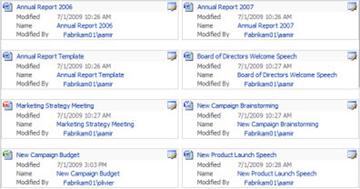
-
Newsletter Displays items in rows with lines between the rows.
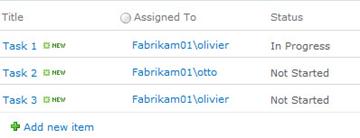
-
Newsletter, no lines Displays items in rows of alternating shades, without the lines between the rows.
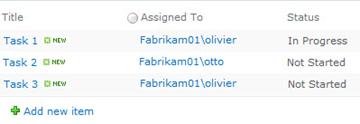
-
Picture Library Details Displays thumbnails of the pictures in a picture library.
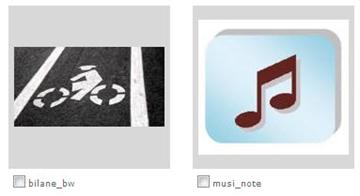
-
Preview Pane Displays the name of the items on the left side of the page. When you point to the name of an item, the columns selected for the view are displayed on the right side of the page.
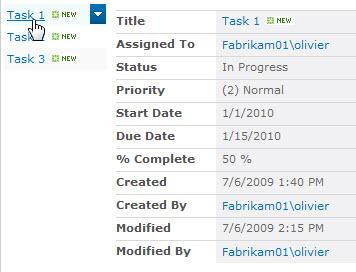
-
Shaded Displays items in rows of alternating shades.
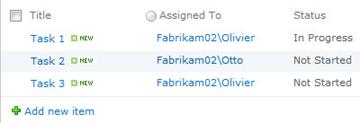
-
-
Folders Select Show items in folders to display the list or library folders in the view with the items. Select Show all items without folders to display only the list or library items in the view, also referred to as a flat view. You may also be able to select whether the view that you are creating is applicable in all folders, in only the top-level folder, or in folders of a specific content type.
-
Item limit You can specify how many items are displayed at the same time (batches) in each view or the total number of items that the view will display. The larger the batch of items in a view, the longer it takes to download in the browser.
-
Mobile You can specify that this view is for mobile devices, is the default mobile view for mobile devices, and the number of items to display in the list view Web Part for this view. This option is not available for all lists and libraries. The view must be a public view.
Create a view
When you look at a list or library, you can temporarily sort or filter the list or library by pointing to the name of a column and then clicking the arrow next to the name. This is helpful if you only occasionally want to see the list or library like this, because you have to repeat these steps the next time that you want to view the list or library this way.
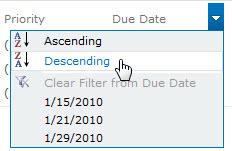
If you frequently have to view information in a list or library a certain way, you can create a view. When you create a view, it is added to the view menu of a list or library.
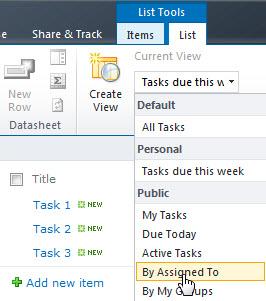
To create a view:
-
On the Quick Launch, click the name of the list or library that you want to create a view for.
If the list or library is not on the Quick Launch, click Site Actions, click View All Site Content, and then click the name of the list or library.
-
In the Ribbon, click the List or Library tab, and then click Create View.
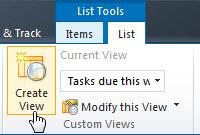
Note: If Create View is disabled, you may not have the necessary permissions to create a personal or public view. For more information about personal and public views, see Settings for views in this article.
-
Click the option, such as Standard View or an existing view that you want to use to create your view.
-
In the View Name box, type the name for your view. Select Make this the default view if you want to make this the default view for the list or library. Only a public view can be the default view for a list or library.
-
In the Audience section, under View Audience, select Create a Personal view or Create a Public view.
Note: If Create a Public View is disabled, you may not have the necessary permissions to create a public view for this list or library.
-
In the Columns section, select the columns that you want in the view and clear the columns that you do not. Next to the selected columns, from the drop-down lists, select the order of the columns in the view.
-
Configure the other settings for your view, such as Sort and Filter, and click OK. For more information about view settings, see Settings for views in this article.
Modify a view
Use the following procedure to modify a view, such as making it the default view, adding columns, and changing the sort order of items in the view.
-
On the Quick Launch, click the name of the list or library that contains the view you want to modify.
If the list or library is not on the Quick Launch, click Site Actions, click View All Site Content, and then click the name of the list or library.
-
In the Ribbon, click the List or Library tab.
-
Select the view you want to modify from the Current View drop-down list.

-
Click Modify this View.
To take advantage of the advanced functionality that is provided by SharePoint Designer to modify a view, point to Modify this View, select the down arrow, and then click Modify in Designer (Advanced). SharePoint Designer 2010 must be installed on the local computer to use this option. If you select this option and it is not installed, you will be prompted to install it. SharePoint Designer 2010 is a free download.
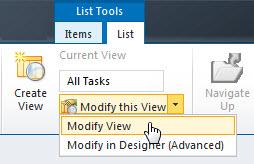
Note: If Modify this View is disabled, you may not have the necessary permissions to modify the current view. You can, however, modify your personal views. You can also modify public views if you have the design permission level for the list or library.
Delete a view
Use the following procedure to delete a view for a list or library.
Note: If Delete is not an option, this may be the default view for a list or library. You must first modify another view and make it the default. For more information about modifying a view, see Modify a view in this article.
-
On the Quick Launch, click the name of the list or library that contains the view you want to delete.
If the list or library is not on the Quick Launch, click Site Actions, click View All Site Content, and then click the name of the list or library.
-
In the Ribbon, click the List or Library tab.
-
Select the view you want to delete from Current View drop-down list.

-
Click Modify this View.

Note: If Modify this View is disabled, you do not have the necessary permissions to modify the current view. You can, however, modify your personal views. You can modify public views if you have the design permission level for the list or library.
-
In the top area of the view, click Delete.
-
When prompted, click OK.
No comments:
Post a Comment